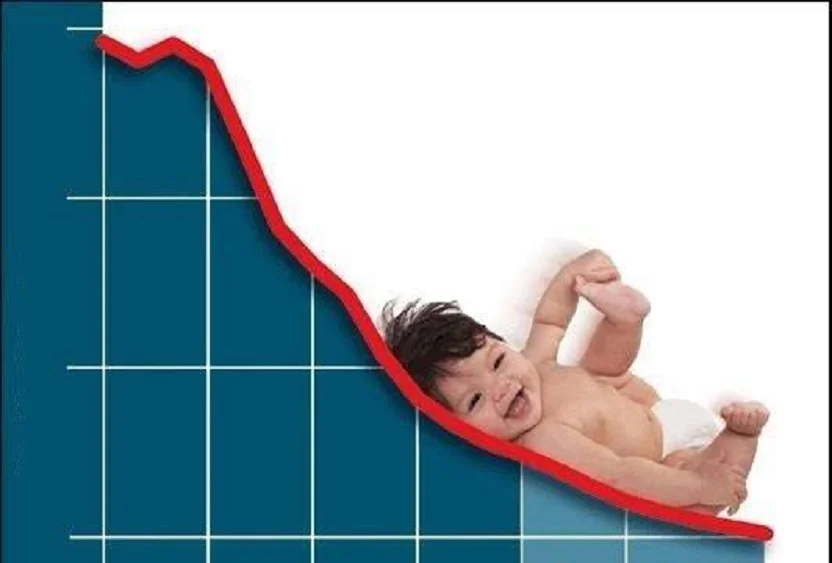
Srinagar– The erstwhile state of Jammu & Kashmir has hit a grueling demographic milestone in the past three years as the latest round of National Family Health Survey for 2019-21 has revealed that J&K has the fifth lowest Total Fertility rate(TFR) in the country besides the women’s TFR slipping below the replacement-level by 0.6 percent.
As per the National Family Health Survey, the replacement level for the fertility rate has been fixed at 2.1 percent, below which, if the rate slips then the fertility crisis is probably in place and also explains the point at which a population exactly replaces itself from one generation to the next.
The NFHS data noted that the fertility rate in J&K has slipped down to 1.41 percent in the 2019-21 NFHS-5 survey from 2.0 percent recorded in the NFHS-4 (2015-16). The recently unveiled survey further notes that among the larger states in India, the highest decline of 0.6 percent in fertility rate between the last survey in 2015-16 and the latest one was recorded in J&K.
The survey further states that in J&K, female sterilization method in which female fallopian tubes are blocked to prevent pregnancy have also declined from 24.4 percent in NFHS-4 to 21.1 percent in NFHS-5 and male sterilization from 0.4 percent in NFHS-4 to 0.3 percent in NFHS-5.
“The total fertility rate (TFR) in Jammu & Kashmir is 14 children per woman, which is below the replacement level of fertility. Fertility has decreased by 0.6 percent between NFHS-4 and NFHS-5,” the report added.
These figures were placed according to the findings of phase two of the National Family Health Survey (NFHS-5). The Government of India, in May, released the key indicators on population, reproductive and child health, family welfare, nutrition and others for India including J&K, clubbed under phase two of the 2019-21 NFHS-5.
Besides this, what looks like lack of awareness and existence of several taboos, about 60 percent of women aged 15-24 years still use cloth for menstrual protection in J&K as the former state ranks lowest in North India in regards of females using a hygienic method for menstrual protection, according to the NFHS report.
As per the data released by NFHS, with 74.5 percent of women using hygienic methods for menstrual protection, J&K ranks the lowest in north India in terms of females using a hygienic method for menstrual protection. The survey has also noted that merely 50.5 percent of women aged between 15-24 years use sanitary napkins. However, the number has substantially increased from 48.8 percent in NFHS-4 (2015-2016).
Pertinently, in the recently released NFHS-5 survey—which provides data by socio-economic and other background characteristics that remains useful for policy formulation and effective programme implementation—women aged 15-24 years in J&K were asked what method or methods they use for menstrual protection, if anything.
With 2116 females answering the questions, it was revealed that 58.4 percent of women use cloth for menstrual protection, 23.1 percent use locally prepared napkins, only 50.5 percent use sanitary napkins, 3.3 percent use tampons, 1.3 percent uses menstrual cup while only 0.3 percent use nothing.
A superficial look at the national rate reveals that in India, 64 percent of females use sanitary napkins, 50 per cent use cloth and 15 percent use locally prepared napkins. “Overall, 78 percent of women in this age group use a hygienic method of menstrual protection.” The report stated.
As per the experts across India, locally prepared napkins, sanitary napkins, tampons and menstrual cups are considered to be hygienic methods of menstrual protection.
However, questioning the veracity of the data, Dr Bilquis Jameel, one of the seasoned gynecologists of Kashmir says that the percentage of women in J&K using cloth for menstrual protection as shown in the report looks fictionally higher than what the reality.
“I personally don’t think that this many females are using cloth for menstrual protection. But, let’s hypothetically believe it’s true, so in that case, if an unclean cloth is reused without proper wash, it increases exposure to multiple severe infections.” Dr Bilquis told Kashmir Observer.
On exposure to infections due to unhygienic menstrual practices, Dr. Bilquis said that in such cases reproductive tract infections like bacterial vaginosis or urinary tract infections (UTI) could occur which eventually become pelvic infections. “And if not treated at an early stage, these infections can travel up to the pelvis and can cause difficulties in getting pregnant or pregnancy complications.” Dr Bilquis said.
Follow this link to join our WhatsApp group: Join Now
Be Part of Quality Journalism |
Quality journalism takes a lot of time, money and hard work to produce and despite all the hardships we still do it. Our reporters and editors are working overtime in Kashmir and beyond to cover what you care about, break big stories, and expose injustices that can change lives. Today more people are reading Kashmir Observer than ever, but only a handful are paying while advertising revenues are falling fast. |
| ACT NOW |
| MONTHLY | Rs 100 | |
| YEARLY | Rs 1000 | |
| LIFETIME | Rs 10000 | |











